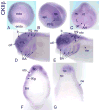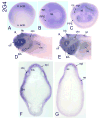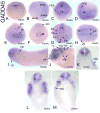Developmental expression patterns of candidate cofactors for vertebrate six family transcription factors
- PMID: 21089078
- PMCID: PMC3059517
- DOI: 10.1002/dvdy.22484
Developmental expression patterns of candidate cofactors for vertebrate six family transcription factors
Abstract
Six family transcription factors play important roles in craniofacial development. Their transcriptional activity can be modified by cofactor proteins. Two Six genes and one cofactor gene (Eya1) are involved in the human Branchio-otic (BO) and Branchio-otic-renal (BOR) syndromes. However, mutations in Six and Eya genes only account for approximately half of these patients. To discover potential new causative genes, we searched the Xenopus genome for orthologues of Drosophila cofactor proteins that interact with the fly Six-related factor, SO. We identified 33 Xenopus genes with high sequence identity to 20 of the 25 fly SO-interacting proteins. We provide the developmental expression patterns of the Xenopus orthologues for 11 of the fly genes, and demonstrate that all are expressed in developing craniofacial tissues with at least partial overlap with Six1/Six2. We speculate that these genes may function as Six-interacting partners with important roles in vertebrate craniofacial development and perhaps congenital syndromes.
© 2010 Wiley-Liss, Inc.
Figures











Similar articles
-
EYA1 mutations associated with the branchio-oto-renal syndrome result in defective otic development in Xenopus laevis.Biol Cell. 2010 Feb 17;102(5):277-92. doi: 10.1042/BC20090098. Biol Cell. 2010. PMID: 19951260 Free PMC article.
-
Zmym2 Alters Expression of Key Craniofacial Genes.Genesis. 2025 Jun;63(3):e70018. doi: 10.1002/dvg.70018. Genesis. 2025. PMID: 40448369
-
Mcrs1 interacts with Six1 to influence early craniofacial and otic development.Dev Biol. 2020 Nov 1;467(1-2):39-50. doi: 10.1016/j.ydbio.2020.08.013. Epub 2020 Sep 3. Dev Biol. 2020. PMID: 32891623 Free PMC article.
-
Using Xenopus to discover new candidate genes involved in BOR and other congenital hearing loss syndromes.J Exp Zool B Mol Dev Evol. 2024 May;342(3):212-240. doi: 10.1002/jez.b.23222. Epub 2023 Oct 13. J Exp Zool B Mol Dev Evol. 2024. PMID: 37830236 Free PMC article. Review.
-
The ZIC gene family encodes multi-functional proteins essential for patterning and morphogenesis.Cell Mol Life Sci. 2013 Oct;70(20):3791-811. doi: 10.1007/s00018-013-1285-5. Epub 2013 Feb 27. Cell Mol Life Sci. 2013. PMID: 23443491 Free PMC article. Review.
Cited by
-
Mcrs1 is required for branchial arch and cranial cartilage development.Dev Biol. 2022 Sep;489:62-75. doi: 10.1016/j.ydbio.2022.06.002. Epub 2022 Jun 11. Dev Biol. 2022. PMID: 35697116 Free PMC article.
-
The Drosophila Wilms׳ Tumor 1-Associating Protein (WTAP) homolog is required for eye development.Dev Biol. 2014 Jun 15;390(2):170-80. doi: 10.1016/j.ydbio.2014.03.012. Epub 2014 Mar 29. Dev Biol. 2014. PMID: 24690230 Free PMC article.
-
Using Xenopus to discover new genes involved in branchiootorenal spectrum disorders.Comp Biochem Physiol C Toxicol Pharmacol. 2015 Dec;178:16-24. doi: 10.1016/j.cbpc.2015.06.007. Epub 2015 Jun 24. Comp Biochem Physiol C Toxicol Pharmacol. 2015. PMID: 26117063 Free PMC article. Review.
-
The Eyes Absent proteins in development and disease.Cell Mol Life Sci. 2013 Jun;70(11):1897-913. doi: 10.1007/s00018-012-1144-9. Epub 2012 Sep 13. Cell Mol Life Sci. 2013. PMID: 22971774 Free PMC article. Review.
-
Pa2G4 is a novel Six1 co-factor that is required for neural crest and otic development.Dev Biol. 2017 Jan 15;421(2):171-182. doi: 10.1016/j.ydbio.2016.11.021. Epub 2016 Dec 9. Dev Biol. 2017. PMID: 27940157 Free PMC article.
References
-
- Abe Y, Oka A, Mizuguchi M, Igarashi T, Ishikawa S, Aburatani H, Yokoyama S, Asahara H, Nagao K, Yamada M, Miyashita T. Eya4, deleted in a case with middle interhemispheric variant of Holoprosencephaly interacts with Six3 both physically and functionally. Human Mutation. 2009;30:946–955. - PubMed
-
- Abdelhak S, Kalatzis V, Heilig R, Compain S, Samson D, Vincent C, Weil D, Cruaud C, Sahly I, Leibovici M, Bitner-Glindzicz M, Francis M, Lacombe D, Vigneron J, Charachon R, Boven K, Bedbeder P, Van Regemorter N, Weissenbach J, Petit C. A human homologue of the Drosophila eyes absent gene underlies branchio-oto-renal (BOR) syndrome and identifies a novel gene family. Nat Genet. 1997;15:157–164. - PubMed
-
- Bai J, Montell D. Eyes absent, a key repressor of polar cell fate during Drosophila oogenesis. Development. 2002;129:5377–5388. - PubMed
-
- Baker CV, Bronner-Fraser M. Vertebrate cranial placodes. I. Embryonic induction. Dev Biol. 2001;232:1–61. - PubMed
-
- Bernard OA, Bisson-LeConiat M, Ballerini P, Mauchauffe M, Della Valle V, Monni R, Nguyen Khac F, Mercher T, Penard-Lacronique V, Paturaud P, Gressin L, Hellig Rl, Daniel MT, Lessard M, Berger R. A new recurrent and specific cryptic translocation, t(5;14)(q35;q32), is associated with expression of the Hox11L2 gene in T acute lymphoblastic leukemia. Leukemia. 2001;15:1495–1504. - PubMed
Publication types
MeSH terms
Substances
Grants and funding
LinkOut - more resources
Full Text Sources
Research Materials

